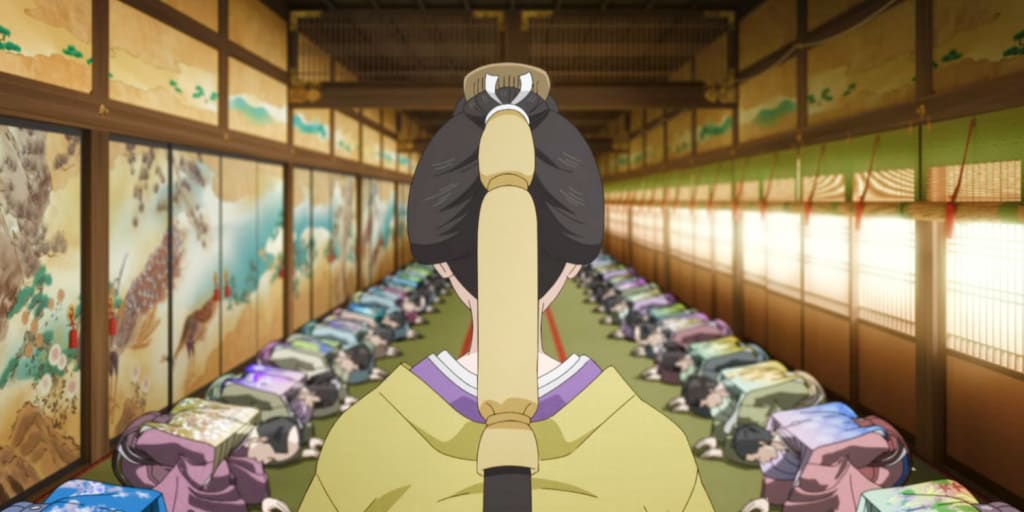"Ōoku: The Inner Chambers" Is A Fascinating Deconstruction of Gender
The matriarchy rises in this Netflix show set during the Edo Period

In today's pop culture lexicon, deconstructions of gender are everywhere. The dystopian TV series Handmaid's Tale, based on the book of the same name, is about what happens when theocratic Christian patriarchy dominates all aspects of the United States. And, of course, Amazonian mythology has been rehashed in everything from Xena Warrior Princess to Wonder Woman.
Netflix's Ōoku: The Inner Chambers is among these stories, as it dared to push boundaries and challenge conventional norms around gender. As an adaptation of a manga series, this show delicately positions itself in a socio-historical context, the Edo or Tokugawa period, when Japan remained insular, shutting its doors to foreign interventions. However, there's an imaginative twist: this self-imposed isolation is due to the devastation of Red-face smallpox, slashing the male populace to a mere fourth of that of women.
This premise allows the series to say many fascinating things about gender while remaining grounded in its historical roots and world-building.
A brief history of plagues
Historically, gender-plague tales have been a mirror to the societal tensions and anxieties surrounding gender politics. Charlotte Perkins Gilman's 1915 creation Herland, envisioned a society that, following a volcano eruption, thrived in the absence of men. Gilman was impacted by the racist underpinnings of first-wave feminism, and her "ideal" society would not be considered great by today's standards. Gilman was a eugenicist, and her narrative explicitly references Aryan superiority, with women refusing to have children with "undesirable traits."
The gender plague stories written following second-wave feminism (roughly starting in the 1960s) tended likewise to be utopian, but the source of that perfection was different. Many characters had progressive ideologies that celebrated diversity, queerness, and polyamory. Unlike in Herland, where society reproduces asexually, Joanna Russ's The Female Man introduces a utopian world called Whileaway, where the women are focused on same-sex relationships and engage in activities such as duels that we would have once considered masculine. It's also a world that writer Sandra Newman notes was created from the genocide of men, alluding to the same eugenicist strand first seen in Herland.
In the current era, many stories no longer relegate male absences to a remote past but thrust them into the throes of the present. The story Y: the Last Man, for example, is not focused on the rebuilding of a post-man world but on the pain that happens immediately during and after the plague, as things are collapsing. As Sandra Newman insightfully notes in The Guardian:
“The 21st-century revival is a very different animal. First, instead of being a dimly remembered political event, the mass death comes now. It has no good aspects. Men die horribly in front of us. Women are plunged into collective grief. Technological society falls apart for lack of skilled workers, and the world goes into decline. Women, meanwhile, are just as violent as men, and no more cooperative or empathic. The only result of generations of indoctrination into female roles is that girls are crap at engineering.”
Newman's commentary here is incisive. Gender plague stories have, until quite recently, created gender-essentialist narratives that turn society into a utopia because the violence of men is no longer present. Even if men disappearing is not an act of God but purposeful, such as in The Female Man, their removal allegedly paints the way for a better tomorrow.
However, this type of thinking can get dicey quite quickly. While, on average, there are many stark differences between men and women, these roles aren't inherently linked to gender and are more about societal conditioning. Women aren't genetically predisposed to make less money at their jobs or be less timid. It's about what we train people to do, and there are people of male sex with feminine traits, and vice versa. Some people fit neither inverse. The premise that you can target maleness or femaleness has historically led to narratives that exclude transgender and nonbinary people at best and malign us at worst. We cannot be blind to this context when we examine such works.
Yet that doesn't mean that gender plague novels should be discarded entirely. There is starting to be more self-aware commentary in this area. Gretchen Felker-Martin's Manhunt, for example, has received much praise for being a gender plague novel written from a trans perspective, and I argue that the complexity of The Ooku: The Inner Chambers is also a text that is a little bit more nuanced in how it deconstructs gender.
Gender Plague in Japan
This brings us to Ōoku: The Inner Chambers, a harmonious blend of past and present storytelling tropes. Initially set 80 years into the matriarchal reign of female Shōguns, in particular, the Shōgun Yoshimune; it paints a world where women dominate every sector of society spanning from trade to households to politics.
The show's title alludes to the Shōgun's harem, the Ōoku, which by Yoshimune's time has a whopping 800 men meant to dot on her reverence — a testament to her formidable power and influence. Originally only some of the men in the Ōoku were meant for the Shōgun's sexual gratification. Most were brought to Edo Castle as a protective, military force to guard the Tokugawa lineage in the wake of potential political instability brought on by the Red Face Smallpox pandemic. When the male heir to the line dies, however, the Ōoku gradually transforms into a harem so that the surviving female heir of the Tokugawa line, Chie, can produce a son.
It's these initial steps to protect the patriarchal control of the Shōgunate that become its undoing. Slowly over time, norms change so that women control more and more of society, and men become decorative playthings for the wealthy. One way to see this is with clothing. Men in the Ōoku initially wear the sparser clothing of the samurai but slowly start to adorn themselves in extravagant attire, in essence, peacocking to appeal to the Shōgun. By Yoshimune's era, although these men still practice the art of the sword, it was largely a ceremonial act. Their real battles are now confined to courtly politics and intrigue.
Yet, this show isn't a mere gender-reversal act that we see in texts such as I Am Not An Easy Man, where women occupy and do all the same things men do now. The narrative is more mature and discerning than that, as the story seems to argue that even the preexistence of patriarchy affects the society that emerges after it. The roots of this matriarchy trace back to the initial years of the Red Face Smallpox. The transfer of power to women was an extended emergency decree, with the underlying premise that it might eventually revert back to patriarchy.
In essence, even while men were dying off, the ascendant female ruling class still had to make the patriarchal men around them feel comfortable.
This appeasement also applied to some women as well. In fact, one of the biggest upholders of the patriarchy in the series is Lady Kasuga, the wet nurse of the male shōgun Iemitsu. Kasuga initially abducted a female child Iemitsu sired out of wedlock named Chie with the purpose of producing a son to extend the Tokugawa line. She wants to restore the patriarchy, not upend it. Chie, who would eventually take on the name of her late father, Iemitsu, cannot initiate the emergency decree to put women in power until after Lady Kasuga's death. Kasuga is so intent on puppeting men from the shadows (as she was trained to do) that she becomes one of the last barriers to the show's ascendant matriarchy.
This is all to say that the shift from patriarchy to uneasy matriarchy wasn't abrupt. It was a gradual process. Women donned male roles, leading to a compelling interplay of gender presentations. Many male heads of noble households exacerbated this shift by pressuring their daughters to secretly take on the role of heir by presenting as men. These female heirs were, in a way, "socialized" as men and many of them found that they preferred the status of men much more than that of women.
Even in the show's current era, women in power are identified by male names, a practice hinting at the vestiges of patriarchy. The character arc of Shogun Yoshimune exemplifies this duality. She's so entrenched in the matriarchal fabric that she's initially oblivious to why she's officially referred to by a male name.
Unsurprisingly, the condition of men 80 years into this alternate future is far from enviable. Reduced to mere carriers of the seed, many are pampered to the point of being infantilized, while others are commodified into sexual servitude. Those in the rural areas, who are no longer sexually viable, are often abandoned in the wilderness.
But notably, it’s still not a complete reversal. The reins of the household, alongside the rest of society, remain firmly in female hands. Men are too precious to tire out and risk getting sick. A combination of history and biology pushes the narrative away from a one-to-one swap with gender, and that is refreshing in an era of lazy gender plague stories.
A viral conclusion
Gender plague stories have been around for over a century. At their best, they provide us with a lens through which to deconstruct gender, but at their worst, they resort to gender essentialism and anti-transness. We often get boring stories that vacillate between the absence of men being depicted as a utopia or a dystopia rather than diving into the messy complexities of what such a disruption would look like.
Ōoku: The Inner Chambers is not just another gender-plague tale but a profound exploration of power dynamics, societal norms, and the intricate weaving and remixing of gender. It challenges, educates, and entertains, making it a shining exemplar of how pop culture can both mirror and mold society's perceptions.
About the Creator
Alex Mell-Taylor
I write long-form pieces on timely themes inside entertainment, pop culture, video games, gender, sexuality, race and politics. My writing currently reaches a growing audience of over 10,000 people every month across various publications.






Comments
There are no comments for this story
Be the first to respond and start the conversation.